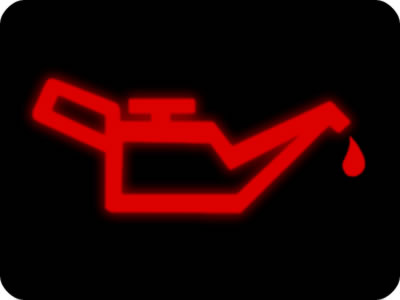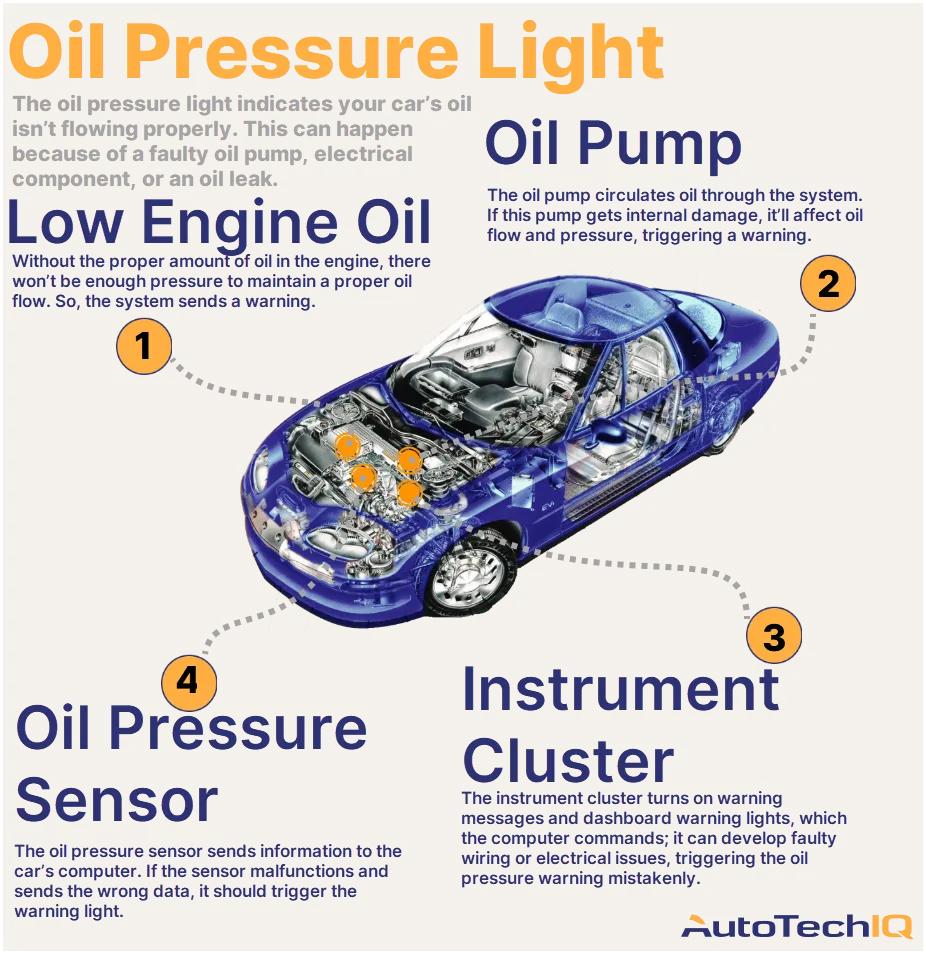Here are the main reasons why does my oil light come on when I brake. Your oil light may come on when you brake if oil levels are low or if there’s a drop in oil pressure. It’s essential to check your vehicle’s oil level and pressure immediately.
Experiencing the oil warning light flicker or staying on during braking can be alarming for any driver. This indicator is a critical alert that something might not suit your car’s lubrication system. Ignoring this signal could lead to severe engine damage due to inadequate oil pressure or low volume.
Drivers should treat this warning urgently, as it often points to issues requiring immediate attention. Ensuring your car’s engine is lubricated correctly is vital for its longevity and performance. Regular checks and maintenance are crucial to preventing such occurrences and keeping your vehicle in optimal running condition.

Credit: www.hoselton.com
Introduction To Oil Light Alerts
The oil light is a crucial dashboard indicator that demands immediate attention. It illuminates when there’s a potential issue with your vehicle’s oil pressure—understanding why the oil light appears, especially when braking, is essential for maintaining your car’s health and safety.
Purpose Of The Oil Light In Your Vehicle
Your car’s oil light serves as a guardian for the engine. It monitors the oil pressure, ensuring the engine’s moving parts stay lubricated. These components can wear down quickly without sufficient oil pressure, leading to significant engine damage.
Common Misconceptions About Oil Light Warnings
Many drivers mistakenly believe the oil light indicates low oil level. While related, it specifically signals low oil pressure, not just volume. Understanding this distinction is key to addressing the underlying issues correctly.
Another common myth is that the oil light is not urgent. Ignoring this alert can result in costly repairs or even engine failure. It’s vital to take immediate action when this light comes on.

Credit: www.countryroadauto.com
Basics Of Car Oil System
The Basics of Car Oil Systems are crucial for any vehicle’s performance. Understanding why an oil light might come on when braking is essential, and it starts with the fundamentals of how oil works within your car’s engine. It’s the lifeblood that keeps the engine components running smoothly.
How Oil Maintains Engine Health
Oil performs several vital functions:
- Lubrication: It reduces friction between moving parts.
- Cooling: Oil carries away heat from the engine.
- Cleaning: It collects and holds contaminants until the next oil change.
- Protection: A protective layer prevents corrosion on engine components.
Without proper oil levels, the engine could overheat, wear down faster, and eventually fail. That’s why an oil warning light is a critical signal that should never be ignored.
Key Components Of The Oil System
The oil system consists of several key parts:
| Component | Function |
|---|---|
| Oil Pan | Stores the oil when the engine is off. |
| Oil Pump | Pumps oil through the engine. |
| Oil Filter | Removes impurities from the oil. |
| Oil Pressure Sensor | Monitors oil pressure and alerts when low. |
Each component must function correctly to maintain engine health. A dip in oil pressure, detected by the sensor, can cause the oil light to illuminate, especially when braking. This is a sign to check your oil system immediately.
Understanding The Link Between Braking And Oil Pressure
Ever wonder why your car’s oil light flickers or stays on when you hit the brakes? It might seem unrelated, but your vehicle’s braking system and oil pressure are connected. As you brake, your car’s dynamics change, which can affect the oil inside the engine. Understanding this relationship is critical to maintaining your vehicle’s health and preventing potential issues.
Effects Of Braking On Oil Distribution
When you apply the brakes, your car’s momentum shifts forward. This can cause the engine oil to move away from the pump, responsible for circulating oil throughout the engine. If the oil level is low or old and thick, it might need to reach the pump quickly enough. This results in a temporary drop in oil pressure, and the oil light may turn on.
Here’s what happens:
- Momentum Shift: Oil moves towards the front of the oil pan.
- Sensor Activation: The oil pressure sensor detects a drop in pressure.
- Warning Light: The dashboard oil light illuminates to alert the driver.
Mechanical Reasons Behind Oil Pressure Fluctuations
Several mechanical factors can cause oil pressure to fluctuate when braking. A worn out oil pump, clogged oil filter, or low oil levels can all contribute to this issue. Regular maintenance is crucial to prevent such problems.
| Factor | Effect on Oil Pressure |
|---|---|
| Worn Oil Pump | Reduces oil circulation |
| Clogged Oil Filter | Restricts oil flow |
| Low Oil Levels | Causes oil starvation |
Address these mechanical issues promptly to ensure consistent oil pressure and a well-functioning engine.
Common Causes Of Oil Light Illumination
The oil light on your dashboard is a critical warning. It tells you something is not right with your car’s oil system. Understanding why the oil light comes on when you brake is crucial for maintaining your car’s health. Let’s explore the common causes behind this alarming signal.
Low Oil Level And Its Impact
A low oil level is a primary suspect when your oil light flickers during braking. This situation can arise from several scenarios:
- Oil consumption over time
- Leaks in the oil system
- Insufficient oil refills during maintenance
Oil serves as a lubricant, protecting engine parts from friction. Without enough oil, parts wear down faster. This may lead to severe engine damage.
Oil Pump Malfunctions And Sensor Issues
Another area of concern is the oil pump. Oil pump malfunctions can cause oil pressure to drop, triggering the light. Common oil pump issues include:
- Wear and tear over time
- Blockage in oil intake
- Broken pump components
Sensors monitor oil pressure and levels. Sensor issues can falsely activate the oil light. Faulty sensors need prompt replacement to avoid false alarms.
Step-by-step Diagnostic Guide
Welcome to our step-by-step diagnostic guide. If your oil light flickers on when braking, it’s a sign to check your vehicle’s health. This guide will lead you through the necessary checks to diagnose the issue effectively. Let’s ensure your car stays reliable and safe on the road.
Checking Oil Level And Quality
Begin by checking the oil level and quality. A low oil level could trigger the oil light, especially when braking. Here’s what to do:
- Turn off your car and wait for the engine to cool.
- Find the oil dipstick and pull it out.
- Clean the dipstick with a rag and reinsert it.
- Remove it again to check the oil level.
- Ensure the oil reaches the marked area on the dipstick.
Examine the oil’s color and texture. Dark or gritty oil suggests it’s time for a change.
Inspecting The Oil Pump And Sensors
The oil pump circulates oil, while sensors monitor pressure. Faulty components can activate the oil light. Follow these steps:
- Locate the oil pump and sensors using your car’s manual.
- Check for any visible damage or leaks.
- Listen for unusual noises from the oil pump while the engine runs.
- Use an OBD-II scanner to read error codes from sensors.
If you find damage or receive error codes, consult a professional mechanic for further assistance.

Professional Vs. DIY Solutions
It faces an oil light that flickers on when braking, which can unsettle any driver. It’s crucial to tackle this issue promptly. Understanding when to seek professional help versus handling the problem yourself is critical. Let’s explore both professional and DIY solutions.
When To Call A Professional Mechanic
Complex issues require a professional mechanic’s expertise. Here’s when you should seek one:
- Oil level remains low after topping up.
- There’s oil leakage under the car.
- Engine noises accompany the oil light warning.
- Oil light stays on despite troubleshooting.
A mechanic will have the right tools and knowledge to diagnose and fix the issue. They can ensure your vehicle’s safety and performance.
DIY Checks And Fixes You Can Perform
Some issues can be fixed at home. Here’s what you can do:
- Turn off the engine and wait for it to cool.
- Check the oil level using the dipstick.
- If low, add oil to the correct level.
- Inspect for any obvious leaks around the engine.
- Ensure the oil filter is tight and secure.
These fixes are simple and can save a trip to the mechanic. However, if the light persists, consult a professional.
Preventive Measures And Regular Maintenance
Seeing your oil light flash when you brake can be alarming. It suggests something might be wrong with your vehicle’s oil pressure or level. Taking preventive steps and performing regular maintenance can help avoid this issue. Below are essential strategies to keep your car running smoothly and prevent oil light warnings.
Routine Checks To Avoid Oil Light Warnings
Maintaining your vehicle well is crucial. Here are some routine checks you should perform:
- Check oil level: Once a month, check your oil level. Make sure your car is on level ground for accurate results.
- Inspect for leaks: Look under your car regularly. If you see any oil on the ground, you might have a leak.
- Monitor oil pressure: Keep an eye on your dashboard’s oil pressure gauge. A drop in pressure could indicate a problem.
By keeping an eye on these aspects, you can catch issues before they become serious.
Importance Of Regular Oil Changes
Changing your oil regularly is vital for your car’s health. Here are reasons to keep up with oil changes:
- Engine lubrication: Fresh oil keeps engine parts running smoothly without overheating.
- Removes engine wear particles and sludge: Old oil can carry debris that harms your engine.
- Improves gas mileage: A well-lubricated engine runs more efficiently, using less fuel.
Experts recommend changing your oil every 3,000 to 5,000 miles, but check your owner’s manual for your specific vehicle recommendations.
Sticking to a regular maintenance schedule helps keep your car in top shape and prevents the oil light from coming on unexpectedly. Remember, a little attention goes a long way in vehicle care!

Credit: www.autotechiq.com
Why does my oil light come on when I brake-Does oil affect brakes?
The Role of Brake Fluid
Brake fluid is a crucial component of a vehicle’s braking system. It transmits force from the brake pedal to the brake pads, ensuring effective braking. The composition of brake fluid is specifically engineered to withstand high temperatures and pressure, maintaining optimal performance.
Effects of Oil Contamination
When oil contaminates the brake system, it can have detrimental effects on brake performance. Oil can seep into the brake fluid through various means, such as leaks from the engine or transmission. Contaminated brake fluid loses its viscosity and becomes less effective at transmitting force, leading to decreased braking efficiency.
Symptoms of Oil Contamination
Identifying oil contamination in the brake system is vital for maintaining safety on the road. Some common symptoms include:
Brake Fade: Oil contamination can cause brake fade, where the brakes lose effectiveness over time due to overheating.
Brake Failure: In severe cases, oil-contaminated brakes may fail completely, resulting in loss of control and potential accidents.
Preventive Measures
Here are some recommended steps:
Regular Inspections: Schedule regular inspections of the brake system to detect any signs of oil contamination or leaks.
Fluid Flush: Periodically flush the brake fluid and replace it with fresh, uncontaminated fluid to maintain optimal performance.
Address Oil Leaks: Promptly address any oil leaks from the engine, transmission, or other components to prevent contamination of the brake system.
Quality Products: Use high-quality brake fluid that meets the manufacturer’s specifications to ensure optimal performance and reliability.
is it safe to drive with oil light Flickering
Driving with the oil light flickering is a potentially hazardous situation that should be addressed immediately. Ignoring the warning light could lead to serious engine damage and compromise your safety on the road. When the oil light flickers, it indicates a drop in oil pressure, which is essential for lubricating the engine’s moving parts. Continuing to drive in this condition can result in engine overheating, increased friction, and ultimately, engine failure. To ensure your safety and prevent costly repairs, it’s crucial to pull over safely, turn off the engine, and check the oil level. If it’s low, add oil immediately or seek professional assistance. Never ignore a flickering oil light, as it’s your car’s way of signaling potential trouble.
oil light comes on at idle but goes off when driving
Experiencing the oil light coming on at idle but going off when driving can be a concerning situation that requires attention. While it may seem like a relief that the light turns off while driving, it’s important not to overlook the initial warning. The oil light illuminating at idle suggests a drop in oil pressure, which could be due to various factors such as low oil level, a faulty oil pump, or engine wear.
Although the light goes off when driving, it doesn’t necessarily mean the issue is resolved. Ignoring the warning signs could lead to serious engine damage and safety risks. It’s advisable to address the issue promptly by checking the oil level and consulting a mechanic if needed to diagnose and fix the underlying cause. Taking proactive measures ensures your vehicle’s health and you safety on the road.
How do you know if your brake oil is bad?
- Visual Inspection: Check the color of the brake fluid. It should be clear or slightly yellow.
- Fluid Level: Ensure the brake fluid level is between the minimum and maximum marks on the reservoir.
- Brake Pedal Feel: Note any sponginess or excessive softness in the brake pedal, suggesting air or moisture in the system.
- Brake Warning Light: Pay attention to the dashboard warning light, which may illuminate if the brake fluid is low or contaminated.
- Brake Response: Test the brakes for responsiveness. If they feel sluggish or less effective, it could indicate deteriorating brake fluid.
- Brake Fluid Age: Consider the age of the brake fluid. If it hasn’t been changed for a long time, it may have degraded.
- Moisture Content: Use a brake fluid tester to check for moisture content, as excessive moisture can compromise brake performance.
- Fluid Contamination: Look for particles or debris in the brake fluid, which can indicate contamination.
- Brake System Inspection: Inspect the brake lines and components for leaks or damage, which can contribute to brake fluid degradation.
- Professional Inspection: When in doubt, consult a qualified mechanic for a thorough inspection and potential brake fluid flush.
why is my oil light flashing but oil is full
- Faulty Oil Pressure Sensor: The sensor might be malfunctioning, sending false signals. A professional inspection can diagnose and replace the sensor if necessary.
- Oil Pump Issues: A failing oil pump could result in inadequate oil pressure despite sufficient oil. A mechanic can assess the pump’s condition and replace it if needed.
- Clogged Oil Filter: A clogged oil filter can impede oil flow, leading to reduced pressure. Regularly replacing the oil filter as part of maintenance can prevent this issue.
- Oil Viscosity: In cold weather, thick oil may struggle to flow properly, causing low oil pressure. Using oil with the correct viscosity for the climate can alleviate this problem.
- Engine Wear: Excessive wear on engine components may result in decreased oil pressure. Regular engine maintenance and inspections can help identify and address any issues early.
Frequently Asked Questions
Why Does The Oil Light Come On When I Stop?
The oil light may come on when you stop due to low oil pressure at idle. Check your oil level and consider an oil pump inspection.
Why Does My Oil Light Keep Coming On But My Oil Isn’t Low?
Your oil light may activate due to a faulty sensor, oil pump malfunction, or electrical issues even if the oil level is correct. It’s crucial to diagnose and address the root cause promptly.
Does Engine Oil Affect Brakes?
Engine oil does not directly affect brake performance, as brakes and engine oil systems are separate. However, a severe oil leak could potentially contaminate brake components, leading to reduced braking efficiency. Regular vehicle maintenance is essential to prevent such issues.
Should I Stop Driving If My Oil Light Comes On?
Yes, immediately pull over and turn off your car if the oil light illuminates. Continuing to drive can cause serious engine damage. Contact a mechanic promptly.
Conclusion
Understanding why your oil light activates during braking is crucial for vehicle health and safety. Regular maintenance checks can prevent potential engine damage. Address this warning sign promptly to ensure a smooth, secure driving experience. Remember, your car’s oil pressure is vital – don’t ignore it!
